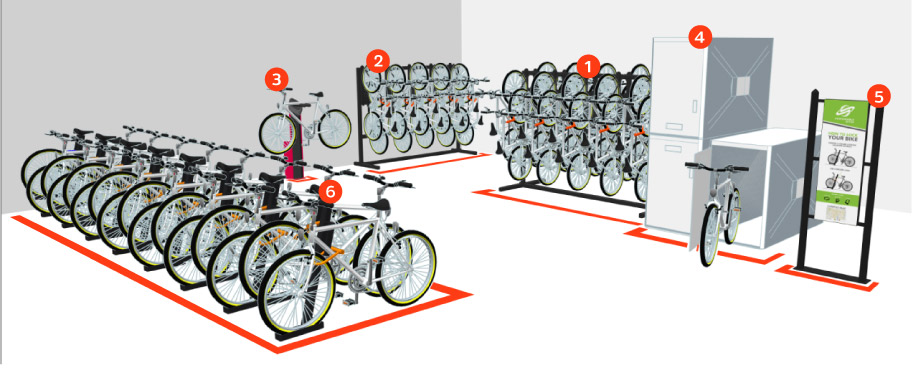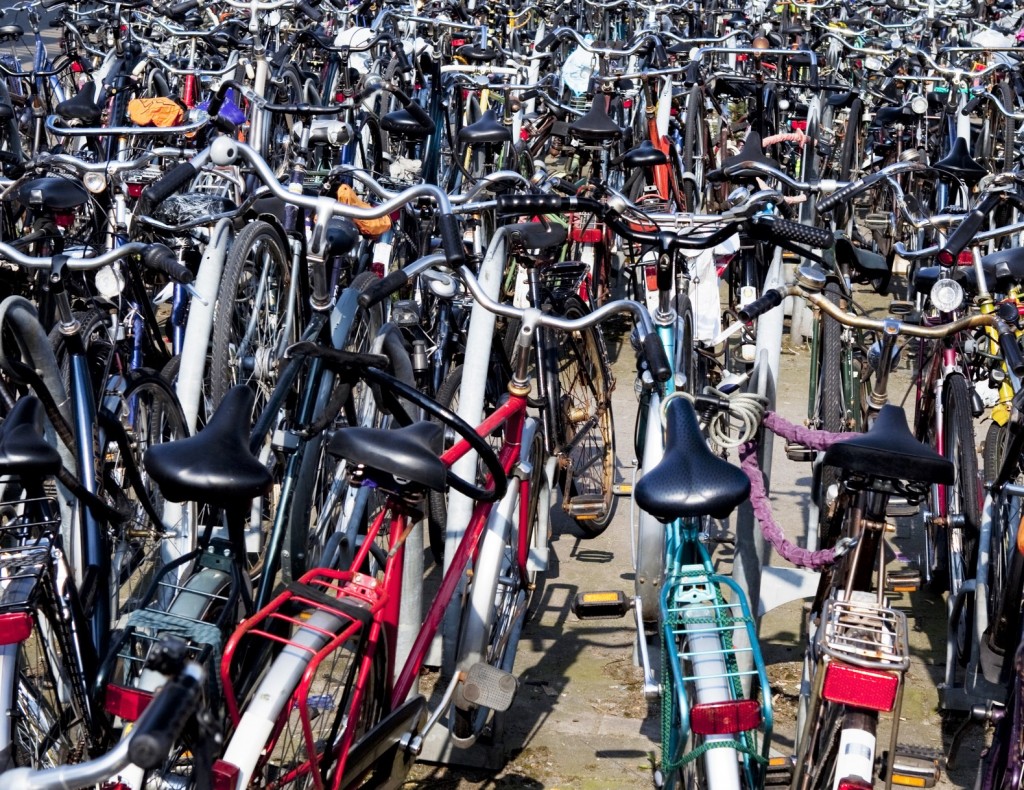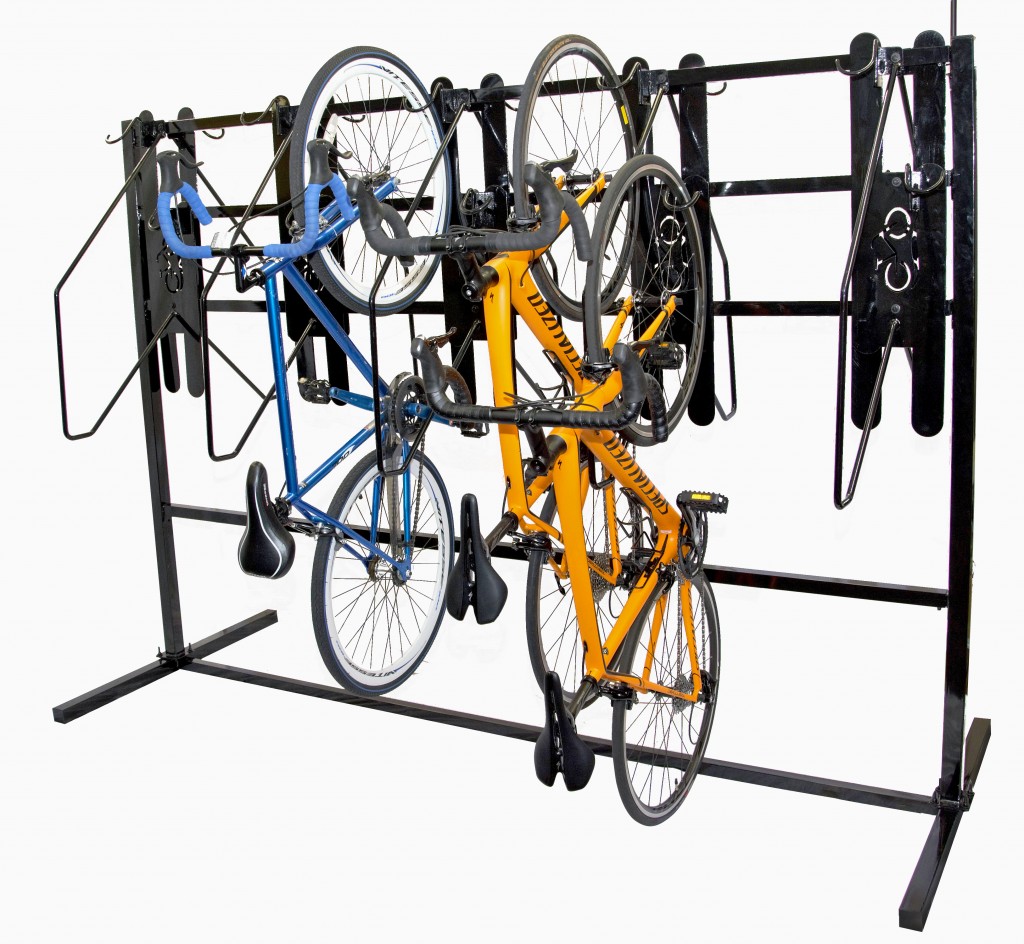 Here is a list of bike room features: 1. DoubleUp 20-bike, double-sided vertical freestanding bike rack 2. DoubleUp 10- bike single-sided vertical freestanding bike rack. 3. Commercial Bike Repair Station and Bike Pump. 4. Single or two-tier Bicycle Lockers. 5. Bicycle Room Signage 6. UpLift Bike Dock with high-density footprint
Here is a list of bike room features: 1. DoubleUp 20-bike, double-sided vertical freestanding bike rack 2. DoubleUp 10- bike single-sided vertical freestanding bike rack. 3. Commercial Bike Repair Station and Bike Pump. 4. Single or two-tier Bicycle Lockers. 5. Bicycle Room Signage 6. UpLift Bike Dock with high-density footprint
As bicycle commuting is on the rise, so is the demand for bicycle storage and in particular, excitement for the addition of bike rooms in apartments and office buildings.
According to The League of American Bicyclists, bike commuting is rapidly growing in bicycle-friendly cities. Washington, D.C. and Portland, Oregon have both seen a growth in bicycle commuter share higher than 400% since 1990.
But even communities that are less bicycle-friendly have seen an overall growth rate of 31% in bicycle commuting. Imagine the impact this increase has on bicycle parking.
Cities and business who fail to add more bicycle parking racks to keep up with the commuter biking trends will likely find their parking areas overflowing, forcing guests to lock their bikes to a tree, or just give up and head to a competitor who offers enough bike parking.
Accessible bicycle rooms used to be a standard thing to offer, but it's quickly becoming more of a selling point.
The upward trend of bike parking
 Disorganized bicycles. Nobody wants a bike room that looks like this
Disorganized bicycles. Nobody wants a bike room that looks like this
Architects who specialize in bike access planning agree that the need for bicycle parking is on the rise. Rich Hiler's team at Essential Design + Build in New York City has architects who have designed bike rooms in the past. He sees the rise in bicycle planning as a necessity in response to the increased bike commuter trend.
"Biking is on the rise as a lesser expensive alternative to public transportation that promotes exercising and, in some cases, enables a quicker commute," Hiler said.
This increase in bicycle commuting impacts the demand for bicycle parkingâ€â€Âespecially parking that is covered and secure. Some cities are mandating bike rooms, but even where it isn't mandated, it's seen as a selling point by many building owners.
"People come to an open house and ask, 'Do you have a gym, a roof deck, a doorman?,' " David Maundrell III, the executive vice president for Brooklyn and Queens new development of Citi Habitats, told the New York Times. "Now they also ask, 'Do you have a bike room?'
For property managers and business owners, you want to answer with a resounding "yes!"
Accessibility and security are essential
If the need for bicycle planning is clearly on the rise, how can city planners and businesses respond to the demand? Part of the key is planning ahead for bike rooms instead of scrambling to add them later on.
According to Hiler, bike storage is particularly difficult in highly urban areas like New York with older building stock. New office building construction requires bike storage with public showers, while older buildings are left searching for retrofit solutions with their existing structures.
"If there isn't an accessible, common area for storage, which is secured, tenants would be bringing bicycles to their office space, which landlords don't love. If bikes are only allowed in freight elevators, most times freight service is closed after 5 p.m., which doesn't suit the commuters who work later into the evening."
 Vertical bike racks are designed specifically to provide high-density parking in bike rooms where space is limited and aisles must be clear
Vertical bike racks are designed specifically to provide high-density parking in bike rooms where space is limited and aisles must be clear
That's why, whenever possible, accessible and secure bike rooms can make all the difference for tenants. If first-story bike rooms are not available, consider larger, separate elevators with 24-hour access.
The accessibility of bike rooms can make such an impact that it can affect the growth of your businessâ€â€Âfor better or for worse.
Luxury apartments nationwide are adding incredible bike rooms to draw in younger demographics that are opting for cycling instead of driving. From secure, luxurious bike rooms in Atlanta, to high-rise bike rooms with a Manhattan skyline view accessible only by elevator, it's clear that this popular cycling trend is taking over the nation.
"The demographic that is driving trends in the luxury residential market values the independence provided by bicycle transit to make the most of urban living," Scott Leventhal, CEO of Trillist real estate development company, told Mansion Global. "Cycling facilitates a more efficient commute, reduces transportation costs and minimizes the need for parking."
Best practices to remember for your bike room
Bike rooms need to:
- Be easy to access, ideally on the first floor. If not, lower level access with an elevator is acceptable, as long as the commuter feels comfortable with the access and security. Don't hide your bike room in some dark, back corner.
- Have security features like security cameras, restricted access, and U-lock bicycle racks. Racks that are compatible with U-locks should allow for three points of contact with the lock: the bike frame, wheel, and the bike rack.
- Offer plenty of space. While one bike per apartment or condo may seem like enough, many tenants are families with kids and couples, who may each own a bike that needs to be stored. Look up your local zoning laws to see if there is a minimum number of spaces required for bike rooms, but consider offering more to meet demand.
- Use higher-density vertical bike racks to maximize bicycle parking in small spaces. These can be freestanding bike racks or wall mount bike racks.
- Include additional features, like individual bike lockers, bike repair stations, compression air pumps, bike valet, or bike rental. Add showers if possible so bike commuters can cool down and refresh.
- Adding short-term and long-term bicycle storage may also make a project eligible for LEED points.
These features may not be essential for your bike room, but they make it much more attractive and increase your chances of convincing future tenants to move in.
Some property owners charge tenants a monthly fee for accessing the bike lockers, ranging from $10-$100 per month. This can be an excellent income generator to help pay for maintenance of the bike rooms. No matter what you decide to charge, make it clear to tenants so they know what to expect to pay for the service.
Above all, open communication is vital, according to Hiler. "There needs to be a harmonious understanding between tenants who want to commute by bike, and landlords who have to accommodate this sustainable trend of transportation," he said.
By offering bike room storage that is secure, accessible, and high quality, your facility will bring in more guests and tenants as you keep up with growing bicycle trends. That's why installing a bike room is a promising investment for your facility.
Note: The Park and Facilities Catalog offers high-density DoubleUp vertical bike racks that can store a large number of bicycles in a small space. We also offer bike repair stations and public bike pumps.


